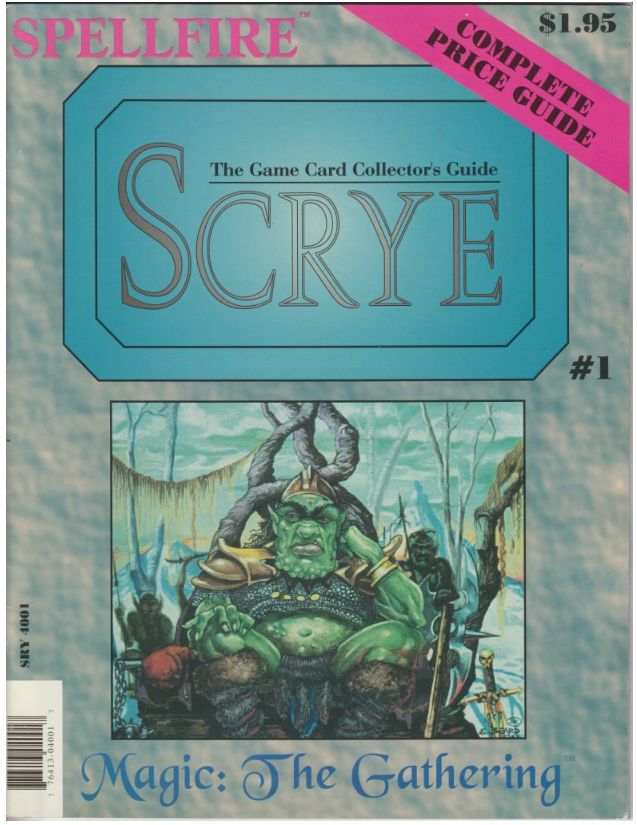What’s my Card Worth?
I’ve been gathering data for over a year so I can share funny charts like these:
So where is this price data coming from? What does it mean? Are they accurate?
1994-2009: Scrye Data.
Before the Internet was a thing, magazines would report prices of collectibles. They did this by calling up stores and asking them what their asking price was for certain cards.
In modern times very desirable / hot cards are worth somewhere between 55-70% of what stores are selling them for. However before the internet was a thing, you couldn’t really buy cards for this price like you can today on Ebay or Tcgplayer.
So I chose to leave the prices as they are. They are usually so low compared to modern days that it really makes little difference.
Whether you bought a card for 100$ or 120$ in 1999 doesn’t matter much when it’s worth 4000$ today.
Here you can see this “Scrye Slump” as you transition the data between 2009 and 2010 where I switch to using MTGoldfish.
This price dip represents a shift from store “asking” price to more of a middle ground. It also shows a crash in the price of undesirable cards. Random garbage rares where always going for 4-5$ according to Scrye but when the internet gained popularity and sites like Ebay or MagicTradersOnline let people trade more efficiently, the price of the undesirable cards plummeted to where they are today: 0.25-0.35$ retail / 0.10$ buylist.
So in the span of a few years a dual land that would previously have traded for 5x of some bulk rare was suddenly trading for 50x or 100x of that same bulk rare. A lot of people have great stories of the amazing ( or terrible ) trades they made back in those days.
2010-Present: MTGoldfish
This is a price aggregator that scrapes TCGplayer to return some kind of rough market price for a card. What does this price actually mean?
A near mint revised Tundra’s market price there is 500$USD. But if you were to buy it on Cardkingdom, you’d pay 630$. If you were to SELL it to Cardkingdom, they’d give you 340$. If you were to buy the cheapest copy on TCGplayer, you’d pay closer to 470$.
Which one of these is the price to use? I will do case studies later on with individual cards and scenarios but there is no good answer to this question because it really depends on how you plan to buy and sell these items. Collectibles are not like precious metals or stocks, they have a very high and variable transaction cost that you can’t easily show in one single graph.
What about very valuable or rare cards?
I’ve had to manually adjust a lot of the prices of very rare cards ( like Alpha ) because the MTGoldfish data can be easily manipulated with a few very high listings on TCGplayer. This is where Cardkingdom comes in because they have an algorithmically set buylist that changes every time someone makes a transaction. The buylist is also a standing offer / floor price for all these cards so that I always know the card is worth AT LEAST THIS MUCH.
You can cross-reference this buylist price with Heritage Auction prices as well.
This price includes the “buyer’s premium” of 20% so if you adjust it down, that 156k card is “worth” about 125k to the seller and the buylist on it is currently 96k.
Fairly close and this is for the most expensive card in the game which has no market price on MTGoldfish. My current price for this card is 130 000$.
What about condition?
All prices used are for near mint. A rough comparison to NM is BGS 8-9 range. That means very high grade cards are not in my data. For instance a PSA10 Black Lotus famously sold for $511 000 in 2021.
The condition in general doesn’t much matter for the data because a lower condition card will have a lower purchase price as well, so it mostly evens out. There are some caveats to this that I will go over in later articles about case studies.
What about sealed?
Scrye did have the price data for these in many instances but the data is sparse after 2010 for the older product. 1993-1994 sealed magic is very rare at this point. I generally use Ebay / Heritage and Facebook groups to gauge the price of the rarer items.
Spoiler alert: This is the stuff you should have been buying this entire time, basically. As late as 2004 this box retailed for around 1500$…
Final thoughts
Do you have any questions? Critiques on my price data? Am I missing something glaringly obvious about this because I’m an artist and not actually a data scientist?
Let me know!




